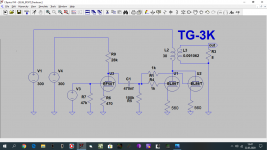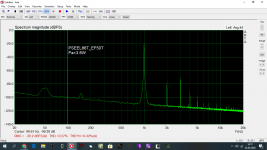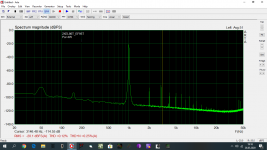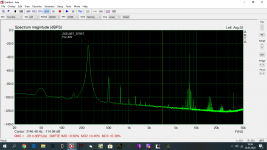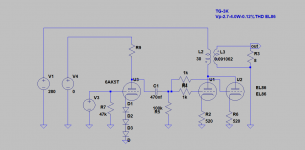Hello.
Maybe there will be someone interested, EL86 in triode end EF50 in triode.
Piotr
Maybe there will be someone interested, EL86 in triode end EF50 in triode.
Piotr
Attachments
Last edited:
The output tubes will run hot for sure, it sure has a little high 3rd harmonic distortion being a SE, tried a bit of feedback?, you can implement a shade feedback (driver and output in pentode mode) between anodes of driver and output tubes, to reduce a bit the thd and the output impedance, or even global negative feedback in triode and pentode mode, but you will loose a lot of gain in triode mode.
I dont know much about this tube but it looks by the datasheets it was used in pushpull OTL amplifiers but at much lower voltages something like 150 Vak, but like most tubes it will surely run more linear at near full anode dissipation, but you can experiment with the output supply also.
I dont know much about this tube but it looks by the datasheets it was used in pushpull OTL amplifiers but at much lower voltages something like 150 Vak, but like most tubes it will surely run more linear at near full anode dissipation, but you can experiment with the output supply also.
Last edited:
That is actually pretty good performance.
The 3rd harmonic is only about 0.8%, even without feedback.
I suspect the driver is near clipping in one direction, at the same time the output tubes are near clipping in the other direction, when the output level is 4.2 Watts.
A lower power level, like 2 or 3 watts will almost certainly have less 3rd harmonic distortion.
A different resistor or loudspeaker impedance (load line), will have a different percentage of 3rd harmonic distortion.
The 2nd harmonic is very good at about 0.1%, so that means the driver 2nd harmonic distortion, in combination with the output tubes 2nd harmonic distortion, has quite a bit of cancellation (because the direction of the 2nd harmonic distortions are in opposite phase).
This cancellation is dependent on the load impedance, since the output stage 2nd harmonic changes with different load impedances (load lines).
but the driver, which can not "see" any change in the output resistor or loudspeaker, will have constant 2nd harmonic distortion at a given signal level.
The 3rd harmonic is only about 0.8%, even without feedback.
I suspect the driver is near clipping in one direction, at the same time the output tubes are near clipping in the other direction, when the output level is 4.2 Watts.
A lower power level, like 2 or 3 watts will almost certainly have less 3rd harmonic distortion.
A different resistor or loudspeaker impedance (load line), will have a different percentage of 3rd harmonic distortion.
The 2nd harmonic is very good at about 0.1%, so that means the driver 2nd harmonic distortion, in combination with the output tubes 2nd harmonic distortion, has quite a bit of cancellation (because the direction of the 2nd harmonic distortions are in opposite phase).
This cancellation is dependent on the load impedance, since the output stage 2nd harmonic changes with different load impedances (load lines).
but the driver, which can not "see" any change in the output resistor or loudspeaker, will have constant 2nd harmonic distortion at a given signal level.
Last edited:
Hi,
No, 280V anode-26V cathode = 254V, Va-g2-250V limit. In the triode connection I powered 330V and there was no problem.
Piotr
No, 280V anode-26V cathode = 254V, Va-g2-250V limit. In the triode connection I powered 330V and there was no problem.
Piotr
EF50? now that's a valve I know about due to its use in UK WW2 equipment ,red tin screen it was used in radar and in many UK WW2 communications radio equipment which I repaired/converted .
Practical Wireless even had a construction circuits to convert old WW2 display equipment into oscilloscopes and TV,s.
Very reliable valve survived in battle conditions in the RAF, well made ceramic base.
Practical Wireless even had a construction circuits to convert old WW2 display equipment into oscilloscopes and TV,s.
Very reliable valve survived in battle conditions in the RAF, well made ceramic base.
Ceramic base? I thought they were one of Philips' first all glass types, with a metal screening can around the bulb.
The original versions in 1938/9 --yes but look at the date .Ceramic base? I thought they were one of Philips' first all glass types, with a metal screening can around the bulb.
The UK declared war in 1939 (September ) and the RAF were supplied the LOCTAL EF50 valves which were all fitted with ceramic bases.
While post war surplus had a great many of them the general public had normal paxolin bases which were judged to be totally inadequate in wartime use .
Although not publicized the RAF designed a circular threaded clamp to hold the valves in place in their wartime bombers ,
and yes I have seen them on a visit to an RAF museum in England arranged for employees who worked at Hawker Siddeley Aviation in KIngston-on Thames where I worked.
There is no mention about (a version of) the EF50 with a ceramic base in this well documented article: The EF50, the tube that helped to win the War
Do you have a picture or an other source for your claim?
Do you have a picture or an other source for your claim?
Look here-
EF50 @ The Valve Museum
EXWD stores after the war were filed with them and 1000,s of ceramic bases for sale as war surplus .
They were also filled with UK bomber command equipment containing them.
Your article is sadly lacking if it doesn't document this unless the article originator is a young person with only second hand knowledge,
mine was first hand.
EF50 @ The Valve Museum
EXWD stores after the war were filed with them and 1000,s of ceramic bases for sale as war surplus .
They were also filled with UK bomber command equipment containing them.
Your article is sadly lacking if it doesn't document this unless the article originator is a young person with only second hand knowledge,
mine was first hand.
I thought that what you apparently call the base of a valve is called a valve holder (tube socket, etc.). I thought that "the base of a valve" ment the underside of the valve itself.
I do not know of any EF50 which has a ceramic underside.
The article i linked to is written by an engineer working at Philips. He has/had access to original sources at Philips. I do not think that his article is lacking anything.
I do not know of any EF50 which has a ceramic underside.
The article i linked to is written by an engineer working at Philips. He has/had access to original sources at Philips. I do not think that his article is lacking anything.
I think we are talking linguistics here and engineering definitions .
Valve bases in the UK mean the sockets they fit into.
Mullard,s own data books label them bases of which I have a large collection as well as Brimar/Osram labeling them bases, as does WW equivalent books and AVO VCM data--I could go on---.
Valve bases in the UK mean the sockets they fit into.
Mullard,s own data books label them bases of which I have a large collection as well as Brimar/Osram labeling them bases, as does WW equivalent books and AVO VCM data--I could go on---.
Hello.
The new project, i.e. PSE_EL86T_EF95T, measurement results for THD and
rarely seen IMD.
Piotr
The new project, i.e. PSE_EL86T_EF95T, measurement results for THD and
rarely seen IMD.
Piotr
Attachments
Last edited:
- Home
- Amplifiers
- Tubes / Valves
- PSE_EL86T_EF50T
